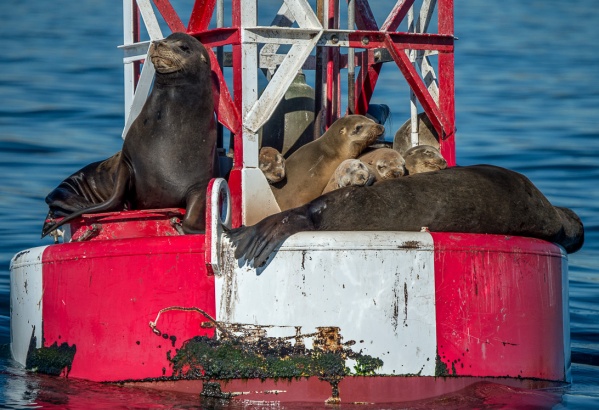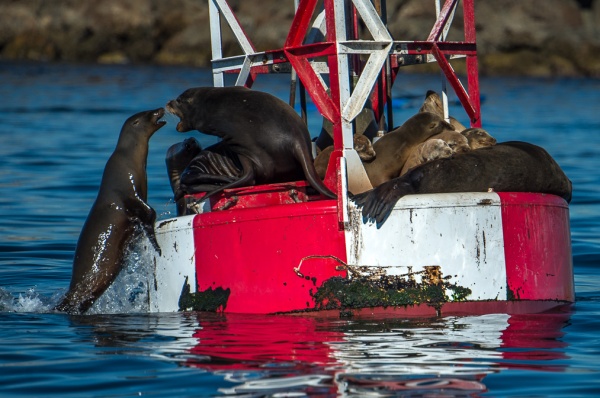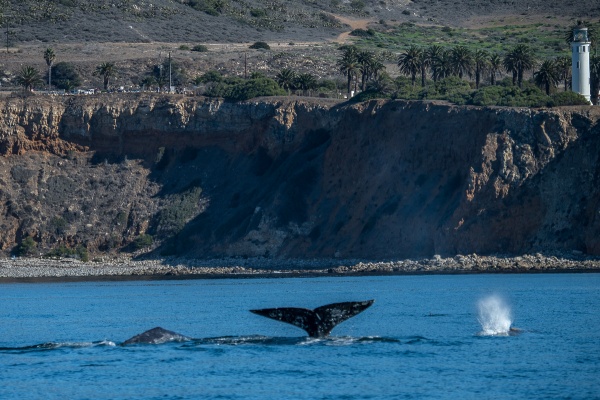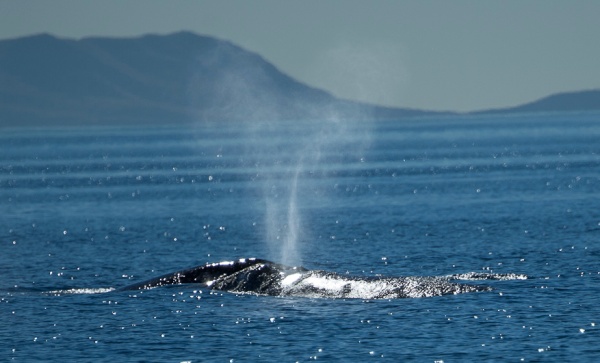Just like the crowded 405 freeway, the coastline off of Ventura, Los Angeles and Orange Counties might need to establish some kind of SigAlert with all the marine mammal activity that’s been seen these days.
Record numbers of gray whales have been reported by the American Cetacean Society (ACS) LA Gray Whale Census and Behavior Project: the number of grays by the end of the month of December capped at 368 grays which broke the previous record of 194 in December 2011.
The grays aren’t the only beast in the sea: orcas, fin whales, blue whales and even humpback whales have been reported up and down the coastline in addition to mega pods of dolphins.
Good windless weather? Climate change? Abundance of food? Cleaner ocean? Scientists may be stumped as why more ocean activity, but one this is for sure: whale lovers should not miss the excursion boats this winter.
When you buy your ticket to a whale watching enterprises, there’s a good chance you will meet a volunteer naturalist who was trained through the Whalewatch Training Program sponsored by the American Cetacean Society at the Cabrillo Marine Aquarium.
“We have about 120 volunteers in our data base and most of them are local to the beach communities here,” says Cathy Hachigian chair of the Whalewatch program which has been around since 1991. Volunteers meet weekly from October through February to learn not just about the whales but also the birds and other pinnipeds that guests will no doubt encounter on any whale watch trip. (Does every whale watching trip involve a buoy packed with sea lions? Apparently, yes!)


Whalewatch volunteers sign up to join cruises from three landings in San Pedro, Redondo Beach and Marina del Rey – right in the heart of whale watching country these days.
Kicking off their season, volunteers embarked on a celebratory whale watch excursion courtesy of Voyager Excursions out of Redondo Beach to test their knowledge, quiz each other and enjoy the cetacean camaraderie on the wide open seas.
Volunteers were treated to a mini training session and a pep talk from Cabrillo’s Programs Director, the always energetic Larry Fukuhara who advised them on a variety of subjects: How to get the attention of a large group, how to demonstrate how big a gray whale is by using 50 feet of rope on the dock, and how to always let the public know that “every day is a good day for whale watching in Southern California.”
As this boat traveled up the Palos Verdes coastline, the excitement grew as a group of four gray whales were spotted. “Look, there’s another one over there!” exclaimed someone. “Too many whales!” said Fukuhara with a smile.

As if they were watching fireworks, the volunteers oohed and ahhed as the whales rose and blew, fluked and dived.

Many tips for the volunteer naturalists were discussed. When grays go down to feed on the bottom (they usually will feed on their way north not south tho), they usually resurface between 3-5 minutes – that waiting time is perfect for volunteer naturalists to get in some quick facts and play “Where Will The Whale Come Up?” games with their whale watchers. Another important tip was discussed: “Let your guests see the blow and tell you they have seen it,” remarked Fukuhara. “Everyone wants to feel like they are a part of the process.”

Volunteer Noly Lira likes to share this interesting fact about the grays: aunties have been recorded accompanying cow/calf pairs on the trek northward. These aunties maybe lost a baby (“they could be grieving”) or they are just sensitive to mama gray’s needs. “The more you understand the whales, I believe the more people will want to protect and help them,” she sums up.
Volunteer Shannon Parks recalls the joy of being constantly followed around by a young boy who constantly asked her questions and observations. “I love that kids are so into it,” she says. But on the flip side, she does get her share of mouth-dropping queries.
Parks describes a straight-faced question she received on an expedition: What kind of whale is Pearl in SpongeBob Square Pants? How did Mr. Crabs have this whale baby? “Popular culture can help raise awareness,” she admits with a laugh citing the Disney flick Finding Nemo as the public’s go-to primer for marine biology. “But we often have to set the record straight – with the FACTS!”
By Brenda Rees, editor
